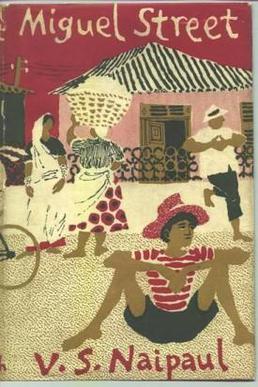
The event was hosted by The University of the West Indies in commemoration of V. S. Naipaul’s 75th year. I had no intention of attending but when the Nobel Laureate arrived in Trinidad and his picture was published on the front page of the newspaper, my younger cousin Marquez asked if I was going to see Sir Vidia Naipaul. I laughed and replied, “You mean, V. S. Naipaul!” He was so excited, and I was surprised because before then, I never imagined that Marquez had any interest in literature. The evening of Naipaul’s reading came and there we were, dressed up and seated. Almost as soon as the program began Marquez fell asleep, first leaning back into his seat, then finally resting his head on my lap. He woke up just in time for the book signing.
The crowd moved without order. There was, however, a line forming at the corner of the stage and we joined. Before long, this very tall white man came and was checking books. He seemed to be sending patrons away. To this day I don’t know for sure what his reasons were for doing so. He checked mine and said nothing, then took the one Marquez had and rejected it. Marquez looked crestfallen. Then, without any appeal, a woman’s reassuring voice reached us, “No! He’s so cute. Let him come.”
This was Lady Naipaul who was standing next to the table at which Sir Vidia was seated. Marquez triumphantly approached them and walked away with his autographed book; initially rejected but ultimately acknowledged.

This experience critically affected my view of the writer. It solidified a distinction between what I imagined of my literary heroes and what the reality of them may be. I had great and deep seated expectation of Naipaul. I started reading his work when I was a teenager, as it was part of the syllabus for English Literature in secondary school and I never stopped. I went on to read for an undergraduate degree in Literatures in English and my post- graduate work is in the same discipline. When people say that his novels are “the books they grew up on”, I perfectly understand because his work was an integral part of my personal and academic development. The years of my life were bound in these narratives. The beloved Miguel Street is told from the perspective of a child and so much of what is presented sounds like the place I grew up and the people who lived there. Naipaul used a reflective narrative perspective in a series of vignettes that focus on one character at a time, showcasing their peculiarities and examining socio-cultural phenomena in each story. The character B. Wordsworth, for example, is a writer who contrives to be like W. Wordsworth. The W is for William but he says it is for white and therefore he is B, the black version. He distills the experience of each month into a single line of poetry and estimates the amount of years it would take him to complete what he calls the greatest poem ever.
At the end of Miguel Street, the narrator is noted, by the characters whose lives he engages through participant observation, as ‘growing up’ and this leads to his eventual departure from the street and the people who live there. He is sent abroad. In the closing lines of the novel he says, “I left them all and briskly walked toward the aeroplane, not looking back, looking at my shadow before me, a dancing dwarf on the tarmac ”(176). At the end of A House for Mr. Biswas the final issue is working out financial support for the child who is going abroad to study. There is the suggestion that the island space is limited and there are more lucrative opportunities that can be accessed beyond it. Also, as with the character B. Wordsworth there is in an investigation of the writing process as Biswas works out his style as a journalist beginning his articles with the same clause, “Amazing scenes were witness when…” Noteworthy is the comparison of these to Naipaul’s autobiographical information. His father was a journalist with the Trinidad Guardian. He grew up with a writer, then became a writer himself and in these early works, explored through characters aspects of the writing process as well as the pursuit of ambition beyond the possibilities offered in Trinidad and Tobago.

This made me think from early about the process of writing, before I had concepts to refer to such as internalized oppression and diaspora in a post-colonial context. I therefore agree with Professor Kenneth Ramchand when he says in The West Indian Novel and its Background that, “The sense of continuity and development in [Naipaul’s] publications arises from the inventive redeployment of a repertoire of traditional novelistic skills and, a steadily darkening tone as a method of writing fiction becomes increasingly a way of seeing the world” (7). This ‘darkening tone’ is found in A House for Mr. Biswas. The titular character has to find his way through a series of domestic and systemic challenges, some of which tether on tragedy.
I remember actually crying as a young person when I read about how, as a little boy, Mr. Biswas looked on with fear as neighbours ransacked his family’s property. His conclusion is that this is the manner in which people treat you when you have no father. My own father had also died in tragic circumstances and I had a great anxiety about what would become of my life. As an adult re-reading the same novel I could see how this grief was pre-consoled by having already read in the prologue that Biswas grew up and, as an adult, had his own things, with a sobering reflection on “How terrible it would have been… to have lived and died as one had been born, unnecessary and unaccommodated.” I could see then how the omniscient writer in this novel of development, gave the reader not just insight into what was going to happen, but also what I felt at the time was, support for the character of young Biswas who did not know.
On a personal level, the ‘dark tone’ of A House for Mr. Biswas was heightened by the guilt I felt about being over familiar with its source material. When I was a child, my aunt’s godfather, Fred Arthur Green, rented the ground floor of the ‘Lion House’ in Chaguanas for his drugstore and lived in a little house to the back. The ‘Lion House’ is the residence of the Tulsi family in the novel. I would frequently visit and many times I unwittingly interfered with items while exploring that building. When I first read the novel I was troubled with anxiety. My aunt’s godfather used to tell me stories about the ghosts he would hear upstairs. I thought these were the spectral Tulsis still occupying the space. I believed I tampered with their sacred belongings and there was a time I really thought that if Naipaul only knew the things I had done in curiosity, he would be so angry with me. The fictional site of the novel was made real and further intriguing by how close it was to my reality. I felt connected to the world of the novel and to the enigmatic writer with whom I had no other connection but a literary one.However, in these early works of Naipaul there is an illuminating element that relates to race relations in Trinidad and Tobago. It was not until I started going to school in Port of Spain for A’ Levels that I was conscious of Chaguanas being a mainly East Indian settlement. I thought the whole country was like this. The borough in Central Trinidad is part of what used to be called the ‘Sugar Belt,’ because of the sugar cane fields that supported the then operational Caroni 1975 Limited. At school, I also became more aware of the perceptions that people in North West Trinidad had about life in Central and South. In 2000 a classmate, believing I lived in “the bush” asked me if I had wild animals in my backyard. Another asked if I was living in an “Indian area.” These were of course ridiculous questions, but stereotypes are built up using exaggerated and oftentimes unfounded ideas.
Part 2/3, Tuesday 15th January 2019


recent articles
A CONVERSATION ART
Light movements.
FILM
ttff/ 2021 is here and watch meh!